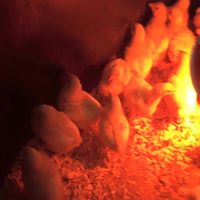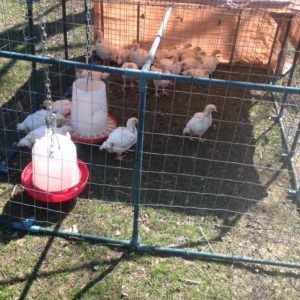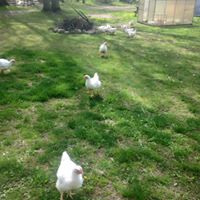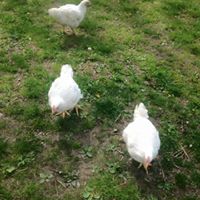Thinking about raising Cornish Cross chickens this spring?
Make sure to do a ton of research, as it’s not the same as raising layers. Meat breeds require different housing, nutritional, and exercise requirements. With the right research and preparation, the experience can go off without a hitch. We have gone about raising the Cornish breed in two different ways: “Method A” and “Method B.” There are pros and cons to both methods, but I believe Method B has fewer downfalls.
Picking Your Stock

It’s so important to start with quality stock. We have acquired meat peeps through both mail-order hatcheries and farm stores. Yes, the farm stores also get their peeps from the mail-order companies, but it’s nice to hand-pick the chicks yourself.
The price point when purchasing direct from hatcheries, especially if in large quantities, can be dramatically lower though. In my experience hatchery quality can be great one year and extremely disappointing the next. We ordered from the same company two years in a row, perfect chicks the first year. In the second year, I received chicks with deformed legs, which were unable to stand nor walk. While the hatchery refunded my money right away, I found it difficult to raise the chicks.
Housing Accommodations

Method A
|

Method B
|
Think ahead when it comes to the housing you choose. Their accommodations will need to be cleaned daily since they defecate way more than laying chicks. We generally use large rubber stock tanks to keep them in for the first few weeks. Then they’re moved to a small greenhouse that we retrofitted for them. The greenhouse is relocated daily for sanitation purposes. We also keep the food and water at opposite ends of the greenhouse so they have to walk back and forth. Keeping fans and/or a heat source is important as well. Depending on the time of year and your climate, you may need one or both while growing them out.
Feeding and Watering

Feeding them is the next challenge. If you’re using Method A, allow them to eat all they want throughout their lives with no restrictions. If using Method B, allow them to eat all they want only for the first three weeks; after that time, they are changed to a twelve-hour on, twelve-hours off food cycle. We feed high-quality high protein feed that we acquired from our local feed mill.
Like our laying hens, we feed fresh fruits, veggies, and treats daily. We set up one waterer with straight water and the other mixed with supplements. It’s important the clean water is available at all times. The second waterer retains either electrolytes, probiotic, or apple cider vinegar depending on the need. Ensuring that the flock has clean well-kept feeders and waterers are imperative for the health of the birds. Therefore change and clean containers daily to guarantee proper sanitation.
Daily Exercise

My little soldiers
Our first year, we followed the six-week Method A procedure, permitting them to eat all day and night. We kept them contained to a chicken tractor, but they appeared miserable. We had a few perish from heart attacks, while others suffered as their legs gave out.
For Method B, we elected to free-range them around the backyard, no less than four to five hours a day, letting them slowly grow for ten to twelve weeks, rather than the normal six to eight. Method B has allowed us to avoid common health issues associated with the breed. We find they get a better quality of life going this route.
We have had no fatalities with Method B. The chickens line up at the door, each morning, waiting to be released. Like little soldiers all lined up, they followed us around the yard daily and happily free-ranged alongside our laying hens. Each evening, as they see the waterers being washed and the greenhouse being relocated, they began to head back towards their home. With a little scratch grain, they easily went in for the night.
Saying Goodbye

The least we can do is allow them to enjoy the short life they have. Method B has allowed us to give them what I believe is a great life. Allowing them to free-range and exercise is key to this concept. We find it hard to let them go each time, as we become emotionally attached following Method B.
With Method A, we don’t seem to become as attached, which makes saying good-bye a bit easier. Maybe the key is to find a middle ground between the two methods? Either way, we give thanks for the nourishment they provide us each and every year. The slaughtering process we found to be extremely sensitive. Some years we pull it together enough to do it on our own, and others we pay to have it done. This I find to be a very personal choice. No matter how you decide to raise them, I hope you do it well and have fun along the way.













5 Comments
How much grower feed per chicken do you provide for method B? Do you feed them a few times a day at designated times, or do you provide a set amount for the day free choice while they roam? I have seen first hand what happens when they are over fed and I wish to avoid this with my own chickens.
Hello can you tell me under what circumstances do you but the differnet items in your 2nd waterer also what do you put in the water and at what ratio
Thank you for this. We are getting our first chicks for meat next week.
We will go with method B or at least what becomes our version of it.
Does it make a difference if I get straight run chicks or all pullets?
Method A vs Method B…confined vs. pasture. Not sure why people try to convince themselves pasture raising is superior for an 8 week broiler. Similar to veal, confined livestock have leaner, more tender meat. Muscling up an already fast growing broiler results in rubbery and tough meat. I’ve used both methods and after one batch of Method B, I only raise my CornishX in confined space, separating the water and feed to encourage some movement. Not sure how others raise their meat birds but my birds have 5 sq yds space each, 12-12 feed schedule, auto bell waterer, spend their days/nights on fresh pine shavings from brooder to grow out pen (I practice deep layer method just like I do for my layers). The chicks are on clean bedding and are forced to balance as they walk which brings the muscle to development without resulting in tough meat. I’ve never experienced leg/heart problems with my birds, nor sudden death. I usually process the same number of birds as delivered day old chicks. My current hatchery sends healthy robust chicks, all remarkably the same size and grow at the same rate – they are quality birds. I always order cocci spray on all chicks. I’ve never experienced mites or fleas on any meat birds but annually have issues with layers that do free range. Folks can raise their birds how they see fit but for me, quality chicks, feed and confinement always delivers sweet tender meat for me.